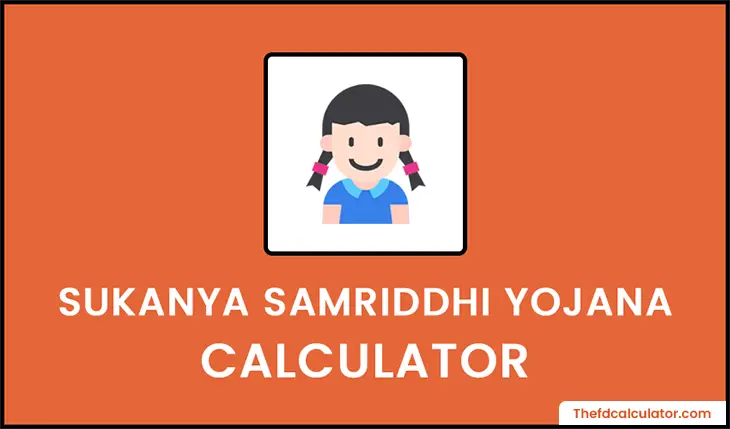Sukanya Samriddhi Yojana Calculator
The sukanya samriddhi yojana (SSY) calculator lets you determine how much amount you will receive at the time of maturity.
What is a Sukanya Samriddhi Yojana Calculator?
The Sukanya Samriddhi Yojana (SSY) calculator is a free tool that helps you to compute the maturity amount and total interest earned before investment.
The current SSY rate is 8.2% per annum. In addition, the deposit period is 15 years, and the maturity period is 21 years. No need to deposit any amount from year 15 to year 21. You will receive interest based on your previous contributions during this period.

How to Use the SSY Calculator?
- Firstly, enter the investment amount per year.
- The SSY interest rate is 8.2%. So, by default, it is set to 8.2. But you can change it if needed.
- Now enter the year from which you start the investment.
- Lastly, press the Calculate button.
- As a result, our tool will display the total investment, total interest earned, maturity amount, and maturity year.
- Also, you can press the Reset button to start the new calculation.
SSY Calculation Formula
| A = P × (1 + |
|
) nt |
Where,
A = Compound Interest,
P = Principal or Invested amount,
r = Annual interest rate (%),
n = Number of times the interest compounds in a year,
t = Tenure in years.
SSY Interest Rate
Sukanya Samriddhi Yojana offers an attractive interest rate. Also, it's revised by the government on a quarterly basis. The following table shows the interest rate since the scheme's inception.
| Time Period | Rate of interest (%) p.a. |
|---|---|
| 01 January 2024 - 31 June 2025 | 8.2 |
| 01 April 2023 - 31 December 2023 | 8.0 |
| 01 April 2020 - 31 March 2023 | 7.6 |
| 01 July 2019 - 31 March 2020 | 8.4 |
| 01 October 2018 - 30 June 2019 | 8.5 |
| 01 January 2018 - 30 September 2018 | 8.1 |
| 01 July 2017 - 31 December 2017 | 8.3 |
| 01 April 2017 - 30 June 2017 | 8.4 |
| 01 October 2016 - 31 March 2017 | 8.5 |
| 01 April 2016 - 30 September 2016 | 8.6 |
| 01 April 2015 - 31 March 2016 | 9.2 |
| 03 December 2014 - 31 March 2015 | 9.1 |
FAQs
Sukanya Samriddhi Yojana is a saving scheme launched by the central government of India. The main intention behind this scheme is to provide a better future for a girl child. Also, it's part of the "Beti Bachao Beti Padhao" campaign. Parents or guardians can use this fund for further education or marriage expenses of a girl child.
A girl child needs to be below 10 years of age to open the account.
Parents or legal guardians can open only one account in the name of a girl child. But per family, up to two accounts are allowed. So, if you have more than one girl child, you can open two accounts for two girl children. In the case of twin girls, you can open three accounts.
You can open an account through any post office or authorized bank in India.
Visit the nearest post office or authorized bank and submit the following documents to open the account.
- Sukanya samriddhi yojana account opening form. You can collect the SSY form from the bank or post office.
- Birth certificate of a girl child.
- Photo ID proof of applicant's parent or guardian.
- Residence proof of applicant's parent or guardian.
- Other KYC proof (i.e., PAN Card or Voter ID).
- A medical certificate is required if multiple children are born at the same time.
You can deposit a minimum of Rs. 250 and a maximum of Rs. 1.5 lakh in a financial year.
The deposit period in the SSY scheme is 15 years. But the maturity period is 21 years. So, you will earn interest on the invested amount for 6 years without depositing funds. But you can deposit more funds if you want.
Withdrawal is only allowed if the girl child attains the age of 18 years or after the maturity period (21 years). If the girl child passes away, the parent or guardian can withdraw the available balance in the SSY account.
Yes, the amount you will receive after maturity is tax-free under Section 10 of I.T.Act.
The account shall be deactivated, and you can re-activate it by paying a penalty fee.